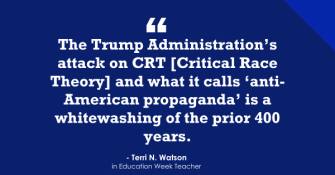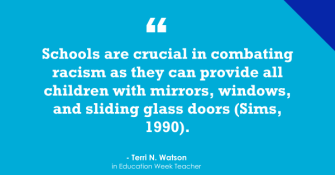Special question:
What should educators know about, and how should they respond to, the Trump administration’s attack on “critical race theory” and what it calls “anti-American propaganda”?
This past week, the Trump administration launched an attack on the teaching of what it considers “anti-American propaganda,” including Critical Race Theory (see Ed Week’s story, .).
Terri N. Watson offers her thoughts in this special guest column.
Race matters
Terri N. Watson is an associate professor in the Department of Leadership and Human Development at the City College of New York. She will spend the 2020-21 academic year as a distinguished visiting scholar at the University at Buffalo’s Center for Diversity Innovation:
Where life is precious, life is precious. —Ruth Wilson Gilmore
Race matters. Critical Race Theory (CRT) provides educators with the tools to understand and challenge the impact of racism in the places that we call schools. Despite the landmark school desegregation ruling in Brown v. Board of Education (1954) and increased federal oversight, America’s public schools remain “separate and unequal.” Black and Brown children are far too often relegated to segregated and under-resourced schools. Deficit mindsets, culturally biased curriculum, and inequitable school funding formulas continue to derail many of the nation’s children.
CRT is founded in the scholarship of Derrick Bell (1930 - 2011). Bell was a civil rights activist, legal scholar, and professor. CRT acknowledges racism as a fact of life for people of color in America and equips educators with the tools to transform schools and increase the learning opportunities for all children. The Trump administration’s attack on CRT and what it calls ‘anti-American propaganda’ is a whitewashing of the prior 400 years.
- 1619 - 1865 = 246 Years of Human Chattel Enslavement
- 1865 - 1964 = 99 years of Jim Crow / “Separate but Equal”
- 1964 - Present = 56 Years of Redlining, Segregation, Mass Incarceration, the State Sanctioned Killing of Black People

CRT is a theoretical lens and an analytical framework. It substantiates race as a social construct and frames the way a collective people experience the world. By placing race at the center of analysis, educators can better understand and interrupt school policies and practices that serve to reinforce white supremacy and promote opportunity gaps. Noted scholars Gloria Ladson-Billings and William Tate (1995) were the first to theorize race in education research. They challenged the multicultural approach employed by many of their colleagues and, instead, utilized race to better understand the disparities they observed in student learning outcomes. Their application of race as a theoretical lens was a watershed moment in education research and gave birth to a new generation of scholars and scholarship.
Below, I employ select CRT tenets to highlight how educators can use them to improve the educational opportunities and outcomes for all children.
The Permanence of Racism
The enslavement of African people coupled with America’s founding charter, the U.S. Constitution, established the subjugation of Black people. And while enslavement was abolished and the Constitution was amended, the nation’s original sin remains palpable in every facet of society. Unfortunately, schools are among the first places wherein most people, namely children, experience racism. It began with the denial of education to nonwhite children and is present in the “separate and unequal” schools that currently exist across the national landscape. Educators must accept this truth and center race, and its offspring, racism, in all of their decisions. Meaning, educators must ask themselves, “How will this activity be perceived by children of color?” “Is it deficit-laden?” “Does it recognize and celebrate the inherit genius, talent, and beauty in all ���DZ����?”

Whiteness as Property
In many ways, whiteness as property can be used to explain the function of education. 69��ý, by and large, promote white middle-class values and norms. Ideologies founded in whiteness are considered the standard in schools, and children who excel at embodying whiteness are celebrated, while those who fail to do so are penalized. The racial disparity in school discipline data throughout the nation best demonstrates this reality. Notably, Black children make up less than 16 percent of the student body nationwide yet represent 39 percent of the students who are suspended from school. And, Black girls, in particular, are disciplined in schools more than most boys and all other girls in every state in the nation (U.S. Government Accountability Office, 2018). Almost all of the infractions are subjective in nature and founded in whiteness. Educators must be aware of the potency and privilege of whiteness and make sure they are not penalizing children for subjective practices. Differences are not deficits.
Counter-Storytelling
Narratives are an effective way to explore the lived experiences of all people. They are essential in countering dominant perspectives as they challenge deficit paradigms of people and communities of color. 69��ý are crucial in combating racism as they can provide all children with mirrors, windows, and sliding glass doors (Sims, 1990). Educators must provide all children with racially diverse curricula that not only celebrate who they are but introduce them to people and experiences that they would not normally encounter. Moreover, if schools are to be liberating and socially just spaces, we must allow children to learn and grow, and this is best done in diverse learning communities. However, studies reveal that more than 65 years after the Brown decision, Black children are most likely to attend schools that are racially isolated and high poverty (Garcia, 2020). Educators must work with school officials and policymakers to ensure that schools are equitably funded and that all children are afforded a rich curriculum and a racially diverse student body.
References
Bishop, R. S. (1990). Mirrors, windows, and sliding glass doors. Retrieved from https://scenicregional.org/wp-content/uploads/2017/08/Mirrors-Windows-and-Sliding-Glass-Doors.pdf.
García, E. (2020). 69��ý are still segregated, and Black children are paying a price. Retrieved from .

Thanks to Terri for her contribution!
Please feel free to leave a comment with your reactions to the topic or directly to anything that has been said in this post.
Consider contributing a question to be answered in a future post. You can send one to me at lferlazzo@epe.org. When you send it in, let me know if I can use your real name if it’s selected or if you’d prefer remaining anonymous and have a pseudonym in mind.
You can also contact me on Twitter at .
Education Week has published a collection of posts from this blog, along with new material, in an e-book form. It’s titled .
Just a reminder; you can subscribe and receive updates from this blog via or And if you missed any of the highlights from the first eight years of this blog, you can see a categorized list below. The list doesn’t include ones from this current year, but you can find those by clicking on the “answers” category found in the sidebar.
I am also creating a
